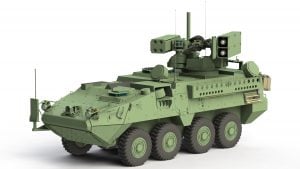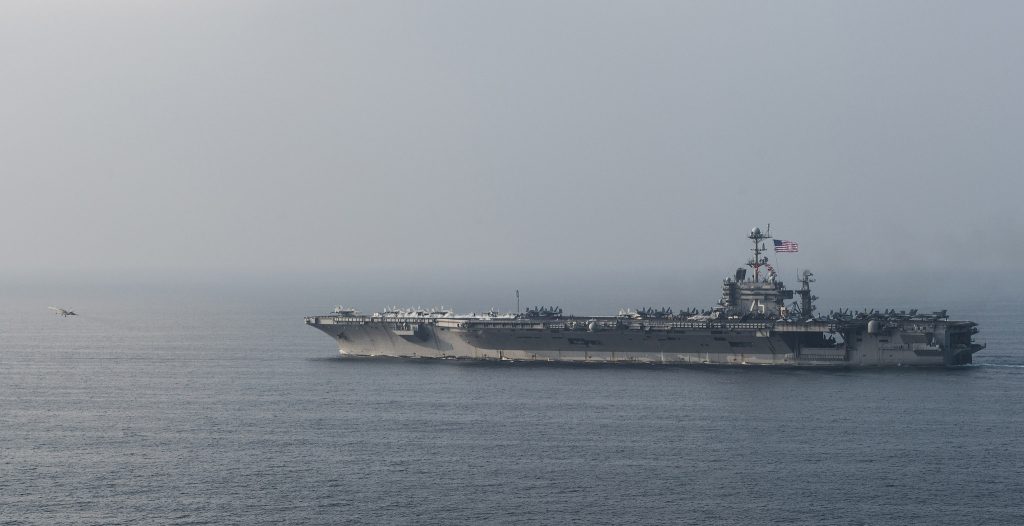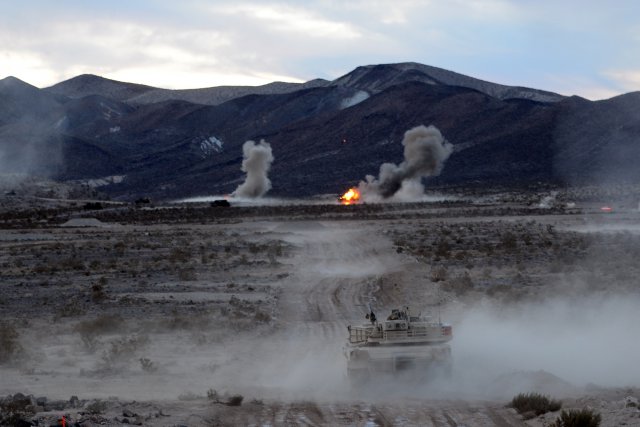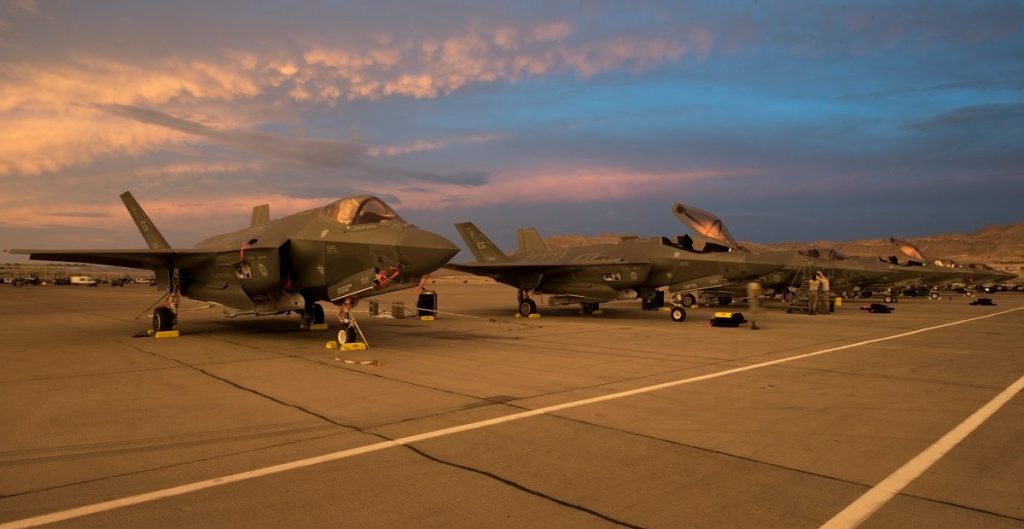US ‘Gets Its Ass Handed To It’ In Wargames: Here’s A $24 Billion Fix
Posted on
WASHINGTON: The US keeps losing, hard, in simulated wars with Russia and China. Bases burn. Warships sink. But we could fix the problem for about $24 billion a year, one well-connected expert said, less than four percent of the Pentagon budget.
“In our games, when we fight Russia and China,” RAND analyst David Ochmanek said this afternoon, “blue gets its ass handed to it.” In other words, in RAND’s wargames, which are often sponsored by the Pentagon, the US forces — colored blue on wargame maps — suffer heavy losses in one scenario after another and still can’t stop Russia or China — red — from achieving their objectives, like overrunning US allies.
No, it’s not a Red Dawn nightmare scenario where the Commies conquer Colorado. But losing the Baltics or Taiwan would shatter American alliances, shock the global economy, and topple the world order the US has led since World War II.
Body Blows & Head Hits
How could this happen, when we spend over $700 billion a year on everything from thousand-foot-long nuclear-powered aircraft carriers to supersonic stealth fighters? Well, it turns out US superweapons have a little too much Achilles in their heels.
“In every case I know of,” said Robert Work, a former deputy secretary of defense with decades of wargaming experience, “the F-35 rules the sky when it’s in the sky, but it gets killed on the ground in large numbers.”
Even the hottest jet has to land somewhere. But big airbases on land and big aircraft carriers on the water turn out to be big targets for long-range precision-guided missiles. Once an American monopoly, such smart weapons are now a rapidly growing part of Russian and Chinese arsenals — as are the long-range sensors, communications networks, and command systems required to aim them.
So, as potential adversaries improve their technology, “things that rely on sophisticated base infrastructure like runways and fuel tanks are going to have a hard time,” Ochmanek said. “Things that sail on the surface of the sea are going to have a hard time.”
(That’s why the 2020 budget coming out next week retires the carrier USS Truman decades early and cuts two amphibious landing ships, as we’ve reported. It’s also why the Marine Corps is buying the jump-jet version of the F-35, which can take off and land from tiny, ad hoc airstrips, but how well they can maintain a high-tech aircraft in low-tech surroundings is an open question).

Anti-aircraft Stryker variant chosen by the US Army for its Maneuver Short-Range Air Defense (MSHORAD) mission: 4 Stinger missiles on one side, two Hellfires on the other, with a 30 mm autocannon (and 12.7 mm machinegun) in between (Leonardo DRS)
While the Air Force and Navy took most of the flak today at this afternoon’s Center for a New American Security panel on the need for “A New American Way of War.” the Army doesn’t look too great, either. Its huge supply bases go up in smoke as well, Work and Ochmanek said. Its tank brigades get shot up by cruise missiles, drones, and helicopters because the Army largely got rid of its mobile anti-aircraft troops, a shortfall it’s now hastening to correct. And its missile defense units get overwhelmed by the sheer volume of incoming fire.
“If we went to war in Europe, there would be one Patriot battery moving, and it would go to Ramstein. And that’s it,” Work growled. “We have 58 Brigade Combat Teams, but we don’t have anything to protect our bases. so what different does it make?”
Worst of all, Work and Ochmanek said, the US doesn’t just take body blows, it takes a hard hit to the head as well. Its communications satellites, wireless networks, and other command-and-control systems suffer such heavy hacking and jamming that they are, in Ochmanek’s words, “suppressed, if not shattered.”
The US has wargamed cyber and electronic warfare in field exercises, Work said, but the simulated enemy forces tend to shut down US networks so effectively that nothing works and nobody else gets any training done. “Whenever we have an exercise and the red force really destroys our command and control, we stop the exercise,” Work said, instead of trying to figure out how to keep fighting when your command post gives you nothing but blank screens and radio static.
The Chinese call this “system destruction warfare,” Work said: They plan to “attack the American battle network at all levels, relentlessly, and they practice it all the time.”

The USS Harry S. Truman, which the Pentagon proposes retiring early to save funds for new kinds of weapons.
The $24 Billion Fix — And Cuts
So how do you fix such glaring problems? The Air Force asked RAND to come up with a plan two years ago, and, surprisingly, Ochmanek said, “we found it impossible to spend more than $8 billion a year.”
That’s $8 billion for the Air Force. Triple that to cover for the Army and the Navy Department (which includes the US Marines), Ochmanek said, and you get $24 billion. Yes, these are very broad strokes, but that’s only 3.3 percent of the $750 billion defense budget President Trump will propose for the 2020 fiscal year.
Work was less worried about the near-term risk — he thinks China and Russia aren’t eager to try anything right now — and more about what happens 10 to 20 years from now. But, he said, “sure, $24 billion a year for the next five years would be a good expenditure.
So what does that $24 billion buy?
To start with, missiles. Lots and lots of missiles. The US and its allies notoriously keep underestimating how many smart weapons they’ll need for a shooting war, then start to run out against enemies as weak as the Serbs or Libyans. Against a Russia or China, which can match not only our technology but our mass, you run out of munitions fast.
Specifically, you want lots of long-range offensive missiles. Ochmanek mentioned Army artillery brigades, which use MLRS missile launchers, and the Air Force’s JAGM-ER smart bomb, while Work touted the Navy’s LRASM ship-killer. You also want lots of defensive missiles to shoot down the enemy‘s offensive missiles, aircraft, and drones. One short-term fix there is the Army’s new Maneuver Short-Range Air Defense (MSHORAD) batteries, Stinger missiles mounted on 8×8 Stryker armored vehicles. In the longer term, lasers, railguns, and high-powered microwaves could shoot down incoming missiles much less expensively.
The other big fix: toughening up our command, control, and communications networks. That includes everything from jam-proof datalinks to electronic warfare gear on combat aircraft and warships. The services are fond of cutting corners on electronics to get as many planes in the air and hulls in the water as possible, Ochmanek said, but a multi-billion dollar ship that dies for lack of a million-dollar decoy is a lousy return on investment.
In the longer run, Work added, you want to invest heavily in artificial intelligence: not killer robots, he said, but “loyal wingmen” drones to support manned aircraft and big-data crunchers to help humans analyze intelligence and plan.
 Of course, you have to find the money for new stuff somewhere, which means either raising the defense budget even further — unlikely — or cutting existing programs. Ochmanek was unsurprisingly shy about specifics, saying only that the services could certainly squeeze out $8 billion each for new technologies.
Of course, you have to find the money for new stuff somewhere, which means either raising the defense budget even further — unlikely — or cutting existing programs. Ochmanek was unsurprisingly shy about specifics, saying only that the services could certainly squeeze out $8 billion each for new technologies.
Work was a little harder-edged. He said cutting a carrier and two amphibious ships over the forthcoming 2020-2024 budget “seems right to me.” He argued the US Army has way too many brigade combat teams — tanks and infantry — and way too little missile defense to protect them. And he bemoaned reports the US Air Force will retire the B-1 bomber, one of its few long-range strike aircraft: If the Air Force doesn’t want them, he said, give them to the Navy, revive the old VPB “Patrol Bomber” squadrons, and load them with Long-Range Anti-Ship Missiles to sink the Chinese navy.
Pentagon leaders should challenge the armed services to solve very hard, very specific problems, Work said: Sink 350 Chinese navy and coast guard vessels in the first 72 hours of a war, or destroy 2,400 Russian armored vehicles. Whoever has the best solution gets the most money. Those are hardly easy goals, Work said, but they’re also doable with technology now in development.
The immediate problems could be fixed with technology already in production, Ochmanek said. For $24 billion, “I can buy the whole kit,” he said. “It’s all mature technologies and it would scare the crap out of adversaries, in a good way.”
Subscribe to our newsletter
Promotions, new products and sales. Directly to your inbox.





